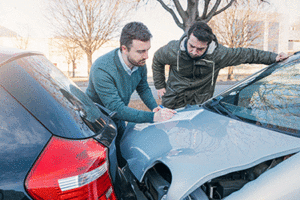Rear end collisions are one of the most common – but luckily one of the least serious – accident types. What is often most complex about these accidents, however, is not the extent of the injuries that they cause, but is determining who is to be held liable for damages.
Because California is an at-fault, or tort liability state for car accidents, determining fault in all crashes that result in damages, even if those damages are minor, is important.
It should also be noted, of course, that while most rear-end collisions are not serious, those that occur at high speeds have the potential to be very severe, and could even be fatal.
Rear-End Collision Fault – Who’s to Blame?
Under California law there is a presumption that if your vehicle is struck from behind, it is the fault of the person who struck you. However, this assumption is what the law refers to as a “rebuttable presumption.” To break down this term, consider that all presumptions are either rebuttable (debatable) or concrete (conclusive), and that a presumption is just an assumption.
As it refers to a rear-end collision, then, what’s meant by a “rebuttable presumption” is that it’s not 100 percent concrete that it’s always the fault of the rear driver, although it is normally considered to be the rear driver’s fault. A situation when the presumption that it is the rear-driver’s fault would not be correct is in a situation where you jam on your brakes for no reason at all and someone rear-ends you; it may not be their fault if you braked without reason.
On the other hand – and when the presumption is true – would be a situation where you jam on your brakes for a good reason such as a car wreck up ahead, or the person in front of you jams on their brakes. If you get rear-ended, it is the other person’s fault because it is every driver’s responsibility to leave a safe distance ahead.
California Laws that Are Relevant in Rear-end Collision Cases
In order to determine fault for a rear-end collision, negligence needs to be determined. Negligence is the failure to act within a reasonable amount of care that is required for a given situation; negligence per se is the breach of a code or statute. In California, acts of negligence or negligence per se that could very much affect liability in a rear end collision include:
- Violation of California’s basic speed law, which states that no person shall drive at a speed other than that which is reasonable or prudent;
- Violation of California’s laws for following too closely, which says that a driver may not follow a vehicle at a distance that is neither prudent nor reasonable;
- Failure to maintain working brakes;
- Failure to maintain working brake lights;
- Stopping suddenly without reasonable cause; or
- Lane changing in a negligent manner.
Clearly, while there are many situations in which a rear-driver could be at fault – namely, when the rear driver is following too closely, has improperly working brakes due to their failure to maintain brakes, or is driving at an unsafe speed – there are also situations in which the forward driver could be to blame.
How to Determine Fault in a Rear-end Collision
In a rear-end crash, it is common for both drivers involved to claim that the other party was at fault. Because of this, it often takes the testimony of a credible, objective third-party witness to establish fault. If no witness is available, accident reconstruction experts may need to be called to the scene to piece together what went wrong and make a determination about fault.
Contact Our Law Offices Today
The experienced rear end collision team at the offices of GJEL Accident Attorneys can help you to understand laws related to rear end crashes in California, and gather the evidence you need to prove the fault of the other driver and hold that driver liable for your injuries. If you have been in a crash and need legal counsel, contact us today for your free consultation.

